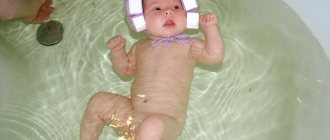Arguments for and against motion sickness. How to rock a baby to sleep and how to wean him off later.
Getting your baby to sleep can sometimes be difficult. Many mothers complain about sleepless nights. What parents and grandparents can’t come up with to finally put their precious child to sleep: fairy tales, lullabies, cartoons before bed, sleeping cuddled with a toy, rocking. Let's focus on the last option - motion sickness. There are so many myths and warnings around this method. Let's try to figure it out based on the opinions of doctors.
Should you rock your baby to sleep before bed?
Arguments in favor of motion sickness:
- Centuries-old experience of motion sickness of ancestors
- Reproduction of movements similar to the intrauterine life of a baby, he is calmer this way
- Feeling the smell of the mother's body, closeness, the baby calms down, feeling safe
- Rocking helps to establish a sense of balance in the child and control of his own body
- In Bobath gymnastics, motion sickness is used to solve some neurological problems
Arguments against:
- The most important argument against is the statement of the famous pediatrician Evgeniy Komarovsky that motion sickness causes dizziness and the child may lose consciousness
- It is very difficult to wean a child from motion sickness
- Harmful for the mother, because the baby is growing and gaining weight. Every month the load on a woman’s back and arms increases
Mom and baby
Arguments for and against motion sickness
Doctors and psychologists have still not come to a consensus regarding the need to put newborns to sleep by rocking them in their arms. In various sources you can find information that indicates the benefits and harms of this ritual. It is important to consider the arguments on each side.
Benefit
Recently, the first 12 weeks of a child’s life are commonly called the fourth trimester of pregnancy. And this name is quite justified, since a baby who comes into this world after the usual mother’s womb needs to adapt to it.
The monotonous rocking of mother's hands or the cradle helps the child experience the same sensations that he felt while in his mother's tummy. As a result, the baby calms down on a subconscious level, feeling safe.
Experts give other arguments in favor of motion sickness:
- Rocking a baby is a traditional practice that has been used by many mothers for thousands of years. Centuries of experience have not revealed the negative impact of this method of placement on children's health.
- Rocking a child before bed means satisfying his need to be close to his mother, in physical contact. It is extremely important for a newborn baby to smell the mother’s body and milk; this develops basic trust in the world.
- Mothers, rocking their babies, help them distract from the unpleasant sensations caused by colic and teething. That is, euthanasia in this way can be called a kind of natural analgesic.
- Rocking movements help calm a cranky or overexcited child in a short period of time. This often happens if there were active games before falling asleep.
- There is an opinion that uniform motion sickness promotes the development of the children's vestibular apparatus. And this helps children quickly learn to maintain balance, crawl, and then, accordingly, walk.
- Measured movements can calm not only the child, but also the mother. And if a nursing woman is in an optimal psychological state, then feeding and other procedures will take place without much hassle.
If the father wants to rock the baby, his request must be granted. Men are less sensitive to the needs of a newborn baby than women, so rocking can help strengthen emotional bonds. And when the baby gets used to his father, the mother will be able to delegate some of her “powers” to the stronger sex.
Harm
Opponents of motion sickness present their own arguments that point to the undoubted harm of this method of putting children to sleep. First of all, researchers indicate that rocking movements prevent full sleep.
As a result, children's sleep can become restless, superficial, and intermittent. Naturally, in this case, the child will not be able to get enough sleep and rest. Why can’t you rock your baby to sleep?
- The vestibular apparatus in newborns is imperfect, so any unwanted interventions can negatively affect children's health. Children experience dizziness and even fainting, which adults mistake for sound sleep;
- If motion sickness has become a habit, then negative consequences arise. The child cannot fall asleep for a long time, sometimes you have to rock the cradle or carry him in your arms for an hour. At the same time, the baby quickly wakes up as soon as he is put into bed;
- Another negative point is that it is extremely difficult to give up motion sickness later on, since the baby refuses to fall asleep without his mother’s many hours of “shaking.” The transition to other laying methods is significantly delayed;
- The child grows up and therefore becomes heavier. If a mother pumps a bottle every evening for 60 minutes, then she faces problems with the spine and pain in her arms. The mother's overwork cannot but affect the baby's well-being.
The famous TV doctor E. Komarovsky has a negative attitude towards motion sickness in infants. He is convinced that even if such a habit does not affect children’s health, it will turn the process of falling asleep itself into a stressful situation for parents and the baby.
Many children independently outgrow the habit of falling asleep in their mother's arms by the beginning of the second year of life. However, some doctors believe that the child should be placed differently at approximately 3 to 4 months of age.
How to rock a child to sleep on a fitball?
Fitball is a large ball for playing sports. With the help of a fitball, you can put your baby to sleep, with benefit for yourself.
Two options for rocking a baby on a fitball:
- Sit on the fitball, take the child in your arms, and slowly jump on the ball. During this time, the muscles of the buttocks and legs are pumped up
- You can put a small blanket or diaper on the fitball, then put the baby on it. Slowly rock from side to side
Child on fitball
How to rock a baby in your arms?
If the mother answered positively to the question whether it is possible to rock the baby to sleep, then now it is important to observe the basic conditions for proper rocking. First of all, you should not rock your baby up and down or at a very fast pace.
Failure to comply with safety precautions can end very badly: increased intracranial pressure or even rupture of brain vessels. It is necessary to rock the child slowly, smoothly, from side to side, avoiding swinging.
How to rock a baby in your arms correctly? will help answer this question :
- cradle. Take the baby in your arms, place him on your forearm, while the baby's neck should be above the elbow. Turn the baby's stomach towards you and support his butt with your other hand. Hold the baby a little closer to you and gently rock, turning left and right. The second option is to just walk around the apartment;
- back to yourself. Place your baby's stomach on your forearm so that the cheek is located in the crook of your elbow. Turn the baby's back to you, pass your other hand between your legs and press your open palm against the baby's tummy. This position is especially useful during the period of intestinal colic;
- lying down. What to do if a parent is tired of standing and walking with a child in his arms? You can rock the baby to sleep in a lying position. Place your baby's tummy on your body and then start rocking from side to side.
If the child cries even after 15 minutes of rocking, you need to check if everything is okay with him. Perhaps the baby is worried about a dirty diaper, wrinkles in the diaper, hunger, stuffiness or teething.
When should you wean your child off motion sickness?
Most children by the first year of life have already weaned themselves from motion sickness and fall asleep on their own. If by the age of one year the child has not learned to fall asleep on his own, you need to gradually accustom him to this. Every month the baby’s weight becomes more and more, the load increases, and motion sickness can lead to health problems for a woman. Another reason you need to teach your child to sleep on his own is that the mother may be away, and at this time the baby should not suffer due to her absence.
Baby sleeping in a crib
Why do you have problems falling asleep?
The opinion that every child necessarily needs rocking to fall asleep is wrong. If the child is absolutely healthy, he is not teething, he is not hungry or wet, then the mother will be able to put him to bed quickly and without any problems.
And yet, it is possible to identify some circumstances that prevent you from falling asleep on your own. Dr. Komarovsky names several such factors:
- Disrupted daily routine. If parents have not developed a daily routine or taken care of discipline, then the child will fall asleep at different times. A baby who is accustomed to a certain routine falls asleep without problems.
- Little activity. A awake child must actively explore the surrounding reality. He needs to be encouraged in every possible way to move, crawl, and roll over. A slightly tired (but not overtired) baby will fall asleep quickly and sleep soundly.
- Incorrect feeding. Malfunctions in the digestive system force the baby to wake up at night. A woman needs to monitor her own diet, excluding the consumption of harmful foods. The same care must be taken when introducing complementary foods.
- Uncomfortable conditions. The inability to put a baby to sleep may be due to an uncomfortable diaper, a wet diaper, loud noises, excessively bright light or a stuffy room. It is important to follow all the rules of healthy sleep.
In addition, as we have already said, a child who is in his mother’s arms feels completely safe. The hug is a kind of reminder of those glory days when he was in his mother's belly.
Thus, one should not go to extremes - rocking the baby for several hours or even ignoring the natural children's desire to receive mother's love and affection.
Some parents, not wanting to accustom their child to motion sickness, try to hold him in their arms as little as possible. In this case, the baby will actually learn to fall asleep on his own, but delayed negative consequences are possible - low self-esteem and disruption of parent-child relationships.
How to teach a child to fall asleep on his own?
At first, teaching a child to fall asleep on his own can cause suffering for both mother and child. The baby is accustomed to a certain regime, for example, rocking on a fitball. He knows in what order this happens. Everything new causes fear in him; he still does not understand what they want from him. If you firmly decide that it’s time for your baby to fall asleep on his own, follow these principles:
- Calm
- Confidence
- Patience
- Repeating the same evening procedures at the same time: bathing, fairy tale, sleep
If you follow the routine and repeat the same actions every evening, your child will get used to it. He will know what comes next. Consequently, he will be confident and calm, and will get used to falling asleep on his own.
If your baby doesn’t want to get used to living independently, try to calm him down with his favorite toy (many children calmly fall asleep with soft toys), a pacifier, tell him a story, or give him a massage.
The child falls asleep on his own
There are several ways to put a newborn to sleep: using a pacifier, a diaper, letting him fall asleep on his chest, and, of course, rocking him to sleep. All these methods satisfy the baby’s natural needs for sucking, contact with the mother, and the creation of soothing conditions similar to intrauterine development. In this article I want to talk in more detail about motion sickness.
Rocking is a way to help calm and relax a child and help him fall asleep faster. And this method has a centuries-old history: for a long time, in different tribes and nationalities, babies were rocked in their arms or in a cradle. To this day, women of the older generation, passing on the experience of motherhood to the younger generation, talk about motion sickness as the only sure way to help the baby fall asleep. Let's look at the pros and cons of motion sickness.
Benefits of motion sickness:
- Rocking in your arms satisfies the baby's need for physical contact with his mother. Helps strengthen psycho-emotional attachment, helps satisfy the basic need for security.
- Smooth rhythmic movements resemble the conditions of intrauterine development. In the mother's tummy the child was in constant motion, and after birth his motor activity was limited due to developmental characteristics. Rocking helps compensate for lack of movement.
- During rocking, the child gradually develops an understanding of space and rhythm. A kind of training of the vestibular apparatus occurs, the child learns to control his body.
Harm of motion sickness:
- Too active motion sickness has the opposite function: it excites the baby’s nervous system, sleep becomes restless and intermittent.
- If rocking is too intense, there is a high risk of developing shaken baby syndrome: an acquired condition in which a baby's brain is damaged due to strong shaking.
- The child’s vestibular apparatus is too weak, active motion sickness provokes dizziness. A popular pediatrician in his book describes situations in which a child simply lost consciousness from motion sickness, and the parents thought that he had fallen asleep.
- A stable association for falling asleep is formed: without rocking, the child cannot fall asleep, and as the child grows, rocking becomes more and more difficult.
- Motion sickness is difficult to refuse. If a child’s habit of motion sickness has become persistent, giving it up is not so easy.
As you can see, it was not in vain that our grandmothers cultivated the method of motion sickness - undoubtedly, there are obvious advantages. But the list of potential dangers is not small. Every new parent makes an informed decision regarding motion sickness for their baby, but I want to tell you in more detail about the safe rules for motion sickness.
How to rock a newborn baby
The modern world offers many different ways to help rock a newborn baby:
- Sun loungers and electric swings . Not recommended for use on newborns. Being in your mother's arms is a vital need for a baby in the first months of life; do not deprive him of this need by entrusting motion sickness to electronic lounge chairs and swings. In addition, these devices can be dangerous for babies under 4 months; read the instructions before use.
- Cradles with a pendulum . Despite its popularity among young mothers, I would not recommend rocking a newborn in bed, again due to the lack of tactile contact with the mother. Rock your newborn in your arms and transfer him to bed after falling asleep. The pendulum mechanism can be used to prolong the baby's sleep: if the baby wakes up earlier than expected and requires rocking to prolong sleep.
- Sling . Convenient and practical solution. The baby is in direct contact with the mother, hears her heartbeat, the mother’s slow movements promote relaxation and rocking, while the mother’s hands remain free.
- Gymnastic ball (fitball). Rocking on the fitball will help the child fall asleep and relieve the mother's lower back. In addition, fitball will be useful for gymnastics at an older age. Safety rules must be followed.
- Mom's hands . The easiest and most optimal way to put your baby to sleep. The baby sees his mother’s face, hears her heartbeat, smells her smell.
If your child can fall asleep on his own without rocking, it is better not to accustom him to it. But if this is the only way to help your baby fall asleep, you should know the rules of safe rocking so as not to harm the newborn.
How to rock a baby in your arms correctly
First, you need to learn how to hold a child in your arms correctly: the baby’s back and neck muscles are still poorly developed, and it is difficult for them to support the weight of their head. It is important for mom to make sure that her back and neck are on a flat surface and that her head is supported.
- Place your baby's back on your arm, between your wrist and elbow, with the head resting on the crook of your elbow. Turn him slightly towards you, so that the child is pressed against you. For convenience, you can swaddle the baby.
- You can place your baby with his back to you. In this case, the baby will lie with his stomach on the adult’s forearm, and his cheek in the elbow area. With your other hand, support the baby's stomach, passing it between the baby's legs.
- Make rocking movements from side to side, at a slow speed and narrow amplitude. Remember, rocking in your arms imitates intrauterine rocking, when the child actually floated in a narrow space where the movements were smooth and measured.
- Keep calm. Rocking in your arms can be prolonged due to various circumstances: colic, the need to communicate with your mother, inappropriate bedtime, etc.
Even if your child starts crying wildly during motion sickness, it is important to remain calm. Do not shake the child, this will cause irreparable harm.
- In parallel with motion sickness, hum a lullaby or tell a story. The voice should be as quiet and calm as possible, you can turn into a whisper.
How to rock a baby to sleep on a fitball:
- Pick up the baby correctly as described above.
- Sit on a fitball. Buy a fitball taking into account the height of an adult. The mother should sit comfortably while rocking the baby.
- Sway smoothly, “right-left” on the ball, with a small amplitude, regulate the movements with the strength of the muscles of the thighs and buttocks.
- Under no circumstances should you bounce the ball up and down, or exceed the speed and range of motion.
Some authors advise placing the baby directly on the ball and rocking it with the child. This method of motion sickness is not safe: Firstly, if a parent accidentally drops the baby, he may forcefully try to hold him by the arm or leg, creating the risk of dislocation of delicate joints; not holding him back will create a risk of injury to the baby. In addition, the rounded shape cannot provide 100% support for an immature spine.
How to rock a baby in a sling
- Buy slings that have a certificate of conformity and are suitable for newborns.
- Before purchasing, consult a specialist. Ask to demonstrate different ways of winding a sling, choose the safest and most suitable for you.
- Place your baby in a sling just before bedtime so as not to exclude the baby's physical activity while awake.
- Move slowly and smoothly. Avoid all sudden movements, do not bend over - squat slowly. Hum a lullaby.
- When the child falls asleep, it is better to transfer him to the crib. If there is no way to shift it, monitor the child’s air supply. When dressing your baby, take into account the fact that you are in a sling to prevent overheating.
How to rock a baby quickly
“How to rock a baby to sleep in a minute?” - the most popular question among young mothers. Indeed, motion sickness often drags on, the mother turns into a rhythmically jumping person, exhausting both the child and herself. It is quite possible for a mother to reduce the time of motion sickness, of course not to one minute, but significantly. To understand how to quickly rock a baby to sleep, you need to know a few simple rules:
- The normal time for a child to fall asleep is from 5 to 20 minutes. If your baby falls within this range, you should not torture him by trying to change the natural course of events.
- Don't get overtired. Follow the rhythm of your child's day. Start going to bed at the first signs of fatigue.
- Find a balance between active and calm wakefulness. The child needs enough exercise to get tired and a period to calm the nervous system.
- Introduce healthy sleep habits. Follow the ritual before rocking to sleep, letting your baby know that it is time to sleep.
How to stop rocking your baby
For some children older than 6 months, motion sickness begins to excite them; moreover, the weight of the growing child does not allow the mother to continue motion sickness, causing pain in the lower back and arms. Sooner or later the time comes to give up motion sickness.
How to do this correctly without harming the small creature?
- Follow your daily routine . A child who follows a routine falls asleep more easily without additional stimulation.
- Always maintain healthy sleep habits . Rituals for waking up and sleeping, dividing waking time into active and quiet, going to bed according to signs of fatigue.
- Try replacing motion sickness with other associations . If a child has heard a lullaby before bed since birth, it will be easier to give up motion sickness by replacing it with a lullaby.
- Teach your child to fall asleep independently . After training, children fall asleep without additional stimulation.
If you decide to give up motion sickness, it is important to do it as gently and comfortably as possible for the child. You should not delay bedtime, trying to avoid motion sickness, otherwise overtiredness will not allow the child to quickly fall asleep and fully recover. Systematic overwork will accumulate chronic lack of sleep, which will subsequently manifest itself in short sleeps and frequent night awakenings.
We help you get rid of motion sickness comfortably in the course “ BABY'S SLEEP. MOM IN RESOURCE .” We begin the course by establishing a “Sleep PASSPORT”. “PASSPORT” is an abbreviation, each letter of which helps to implement healthy sleep habits and build a daily rhythm that suits your baby. Next, we work with associations: we remove strong associations, such as motion sickness, and teach the child to fall asleep on his own. And throughout the course we work with the resource of a mother tired of motion sickness. To reserve a place on the course, write your name and phone number (with code).
Author: Tatyana Kremneva.
How to rock a baby correctly: tips and reviews
Christina: “I didn’t teach my daughter to get motion sickness. It came out naturally. When she was already 10 months old, my lower back hurt a lot. I decided it was time to wean myself off. At first there were hysterics and screams. I had no strength. To begin with, I taught her to rock her to sleep in her crib, but then I got tired of that too, tired of sitting by the crib for half an hour. Once I decided that that was it - let her sleep on her own. We had a good walk during the day, took a bath, played before bed, then left her on her own. She, of course, twisted and whimpered, but fell asleep. So gradually we got used to it.”
Maria: “My son’s crib is in my bedroom. Initially, I didn’t accustom him to rocking, I fell asleep under my chest, then I just put him in my crib. When I weaned him, I started playing him an audio story. I fell asleep with a bang. Now he’s 2, he falls asleep on his own without my active participation.”
To rock or not is the independent choice of each parent. Listen to yourself, your child, and you will be able to make the right decision.
Motion sickness using devices
If a mother is tired of rocking her baby in her arms, then you can purchase one of the many devices to carry out this process. Stores offer a wide selection of similar devices: cribs, strollers, rocking chairs and other “miracles of technology.” Let's talk about them in more detail.
Rocking center
A similar device is a hanging cradle, which is distinguished by the presence of many settings.
Mom can adjust the back angle, rocking mode, and music that will entertain the small child. Additionally, the child is secured using safety straps.
Why is such a product needed? With its help, parents will be able to take a break from motion sickness and spend a few minutes on household chores or personal matters. It is only important to choose a device suitable for newborn babies.
The center has many advantages. The only disadvantage of such a rocking device is its high cost.
Chaise lounge chair
This device is not as expensive as a motion sickness center. However, its functionality is somewhat limited. The lounge chair is equipped with vibration, music and hanging toys.
This product is usually used from birth to 9 months of age. To make it comfortable for the newborn to lie down, a special anatomical insert is placed in the chaise lounge.
These chairs are very mobile. Parents note that the device can be folded and taken with you on a long journey. However, among the disadvantages one can highlight a short service life.
Swing chair
Such devices are also called rockers. They work thanks to rounded metal runners on which the baby cradle is installed. The swing is set in motion by the baby's movements or the efforts of an adult.
You can block the movements of the swing using special legs located in front and behind. Such devices are equipped with various functions: vibration, arc toys, music, light effects.
Car seat category “0+”
You can rock a newborn to sleep using a car carrier, although this holding device is intended primarily for transporting babies in a car.
High-quality baby carrier models have a rocking function due to the rounded base.
That is why many mothers adapt such devices for rocking their baby, although they will have to make some effort.
In general, it is enough for a mother to simply rock the chair with one hand, and at the same time she can read a book, listen to her favorite music or enjoy a tasty drink.
Stroller
Despite the fact that not all experts have a positive attitude towards the idea of rocking a child to sleep in strollers, babies usually fall asleep very well in these vehicles.
Fresh air and gentle movement help you sleep quickly and soundly. It makes no sense to talk in detail about this device, but it is important to clarify that not all strollers have a motion sickness function. It is worth choosing bassinets designed specifically for newborns.
Sling
A fabric baby carrier is an excellent option for rocking a baby to sleep without interrupting important work. This device provides uniform support for all parts of the spinal column and the child’s head, involves close contact between the baby and the mother, and also frees up the hands.
The only drawback is that the mother needs to get used to wearing a sling and the weight of a baby. In addition, it is necessary to choose the optimal device for a newborn baby, since not all headbands are suitable for the smallest children.
Ergo backpack
Another version of a sling, only it resembles a backpack rather than a bandage. This device is used for carrying and rocking babies who can already hold their head and sit quite confidently.
The baby sits behind the mother's back or faces her, which is also useful for forming strong parent-child relationships. The process of motion sickness itself occurs due to the uniform movement of the parent with this same backpack.
Fitball
A large inflatable ball is a great helper for the whole family, as it allows you to do fitness, do exercises with your baby and rock the little person to sleep.
There are 2 main ways to rock a child on an inflatable ball:
- The mother sits on the ball, takes the child in her arms, and slowly jumps on the fitball.
- A small blanket or diaper is placed on the ball, and only then the child is placed on the device. The fitball is smoothly swung from side to side.
Choose your fitball very carefully. To prevent motion sickness from causing any inconvenience to you and your child, you need to choose a device taking into account your height.
Hammock
Hanging net is a great outdoor accessory. However, some mothers successfully use a hammock to rock their baby to sleep. Naturally, one child cannot be placed on it. First, the mother lies down in the net, and only then puts the baby on top of her.
To avoid injury, you need to pay attention to the fastening of the suspension device. Also, we must not forget about the soft mat, which is placed directly under the hammock.
How parents can get rid of motion sickness
Many tired mothers ask pediatricians not only how to rock their baby to sleep, but also how to get rid of the acquired habit.
Of course, you won’t be able to put your baby to bed in 50 seconds, but you can still gradually simplify your life. Here are the basic tips:
- While awake, parents need to pay constant attention to the baby. He needs to be held, hugged, massaged and carried in a sling.
- The mother can place the baby next to her during the period of falling asleep. You don't have to sleep with him. This is done in order to create a feeling of security and safety in the baby.
- Some experienced mothers come up with little tricks. They leave their T-shirt in the baby’s crib, which retains a familiar smell. Older children willingly fall asleep with soft toys.
- It is not recommended to put your child to bed in complete darkness. You need to turn on the night light, and mom should sit next to you and hum lullabies.
- The child needs a regular bedtime ritual, which includes evening bathing, massage, and a lullaby. This will help him fall asleep on his own without motion sickness.
As a result, the baby will be able to sleep soundly. And parents won’t have to find out from experts how to quickly rock their baby to sleep. The process will take place naturally and will not require any effort on the part of the mother.
Minuses
Opponents of motion sickness have their own arguments that point to the negative impact of this method of placing a child. First of all, they claim that rocking movements prevent you from falling asleep fully.
As a result, children will wake up more often than usual and behave restlessly. Therefore, the child will not be able to fully rest. What are the harms of motion sickness?
- The vestibular system of a newborn is in a developing stage, so unwanted interventions can negatively affect his health. Children even experience dizziness and fainting, which adults mistake for sleep.
- Sometimes motion sickness becomes a habit. As a result, the baby cannot fall asleep, and therefore parents have to carry him in their arms or rock the cradle. However, he quickly wakes up when he is put in his crib.
- When the child grows up and the mother wants to switch him to other methods of laying him down, this will be met negatively on his part. Getting used to other methods will take an indefinite period of time.
- The baby is growing and becoming heavier. If the mother carries him in her arms for an hour, she is guaranteed to have pain in her back and arms. And her overwork can negatively affect the health of the baby.
Many children give up the habit of sleeping in their mother's arms by the end of the first year of life.
Advice from Dr. Komarovsky
The famous pediatrician Komarovsky is sure that motion sickness, if it does not affect the baby’s condition, will create a stressful situation for the whole family.
Here are the main expert tips:
- From birth, a child should have a daily routine. If he goes to bed at the same time, he will not have any problems falling asleep.
- A well-known pediatrician does not advise parents to put their baby to sleep next to them. Over time, this habit will create problems not only for the mother, but also for the child himself. Therefore, he must have his own sleeping place, starting from birth.
- When a child gets older, he must sleep not only at night, but also during the day. This is important for its proper development. However, during the day he should not sleep more than 2-3 hours. If you don't follow your bedtime, it will be quite difficult to get to bed in the evening.
When parents are interested in how to rock a child to sleep, they understand that he will not be able to develop the habit of falling asleep quickly on his own. Mom and dad should help him with this. Thus, they care not only about the child’s health, but also about their own.
Mom's hands soothe and heal
In infancy, no one can rock you to sleep like your mother
Rocking in your arms helps the child feel the closeness of a loved one and gives a feeling of security. The baby plunges into a state close to the one in which he was in his mother’s stomach. He spent 9 months peacefully swaying in the amniotic fluid, so the child perceives any similar sensations as pleasant and familiar.
The gentle rocking calms the baby and has healing powers. Carrying it in your arms helps synchronize the work of internal organs, and human warmth contributes to the maturation of the nervous system and the entire small organism. For colic and headaches, loving hands are the best medicine.
In addition, close physical contact between mother and baby strengthens emotional bonds, allowing the newborn to develop harmoniously.
To ensure a sound sleep, infants often only need their mother’s presence without walking or rocking. Try sitting with your child in a chair or on the sofa. To create a cozy “nest”, use pillows and blankets; it is advisable to place them under the back and arm on which the baby’s head is located.











